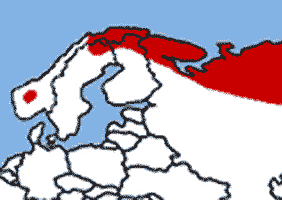|
*** REINDEER OF LAPLAND *** |
||||

Reindeer Distribution in
Arctic Europe |
Reindeer are native to the Arctic regions and vary in colour and size. Both sexes grow antlers afresh each year which initially are covered with soft velvet. Reindeer have adapted to survive Arctic winter temperatures and conditions: their two-layered fur has a dense undercoat and longer overcoat of hollow, air-filled hairs: their noses have increased surface area to warm and moisten incoming cold air, and their hooves are adapted to support their weight on snow. Reindeer are ruminants grazing on birch and willow leaves and grasses in summer and moss and lichen in winter. Sámi peoples have traditionally lived by herding semi-domesticated reindeer for meat, hides, antlers, milk and for transportation. The Sámi life style gradually evolved from nomadic to pastoralist as reindeer herds were domesticated and increased in size; the mid-20th century advent of mechanisation meant that reindeer herders could travel out from settled villages on snowmobiles to the grazing grounds and herds are now tracked by GPS technology. The are now some 230,000 semi-domesticated reindeer grazing freely in Lapland, and Sámi herders still use traditional patterns of calf ear-marking to identify their stock in the high fells between June and August with herd separation and culling taking place in mid winter. Our Reindeer photos were taken in Finnish Lapland mostly at the Salla Poropuisto |
|||
| <Click on Thumbnail for full-sized picture - then Click on full-sized picture to return to Thumbnails> | ||||
 |
 |
|||
 |
 |
 |
||
 |
 |
 |
||
 |
 |
 |
||
 |
 |
 |
||
 |
 |
 |
||
 |
 |
 |
||
| <Click on Thumbnail for full-sized picture - then Click on full-sized picture to return to Thumbnails> | ||||
|
|
||||







